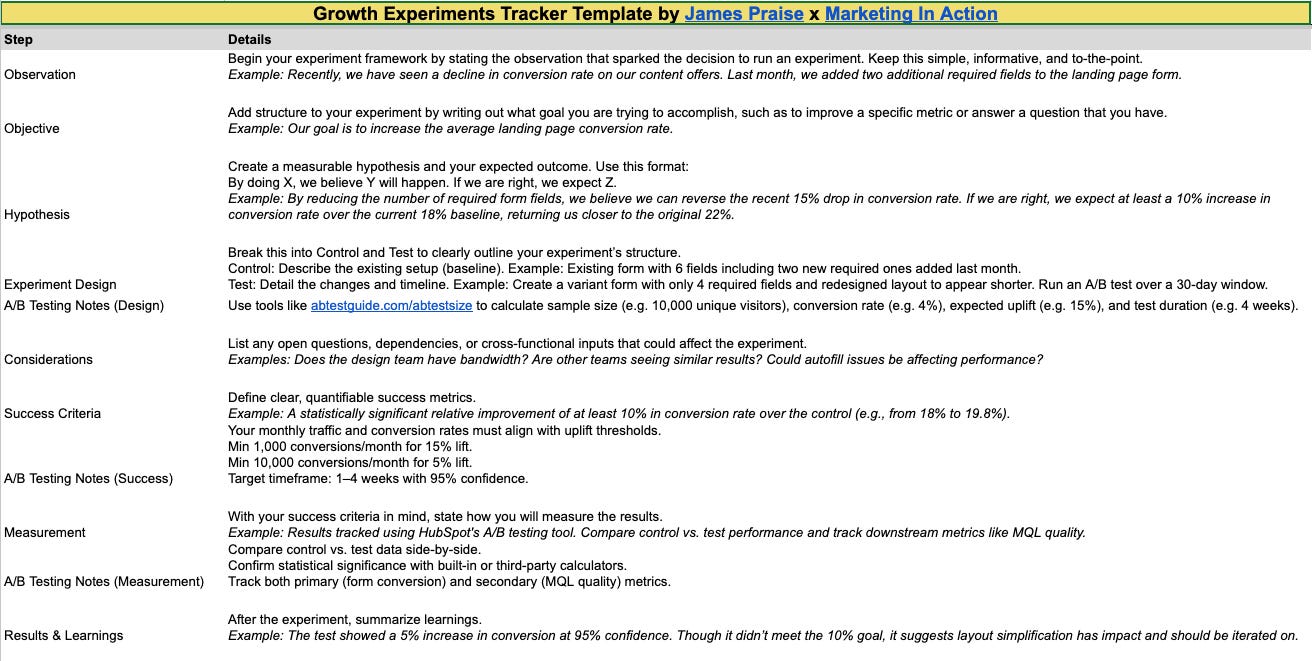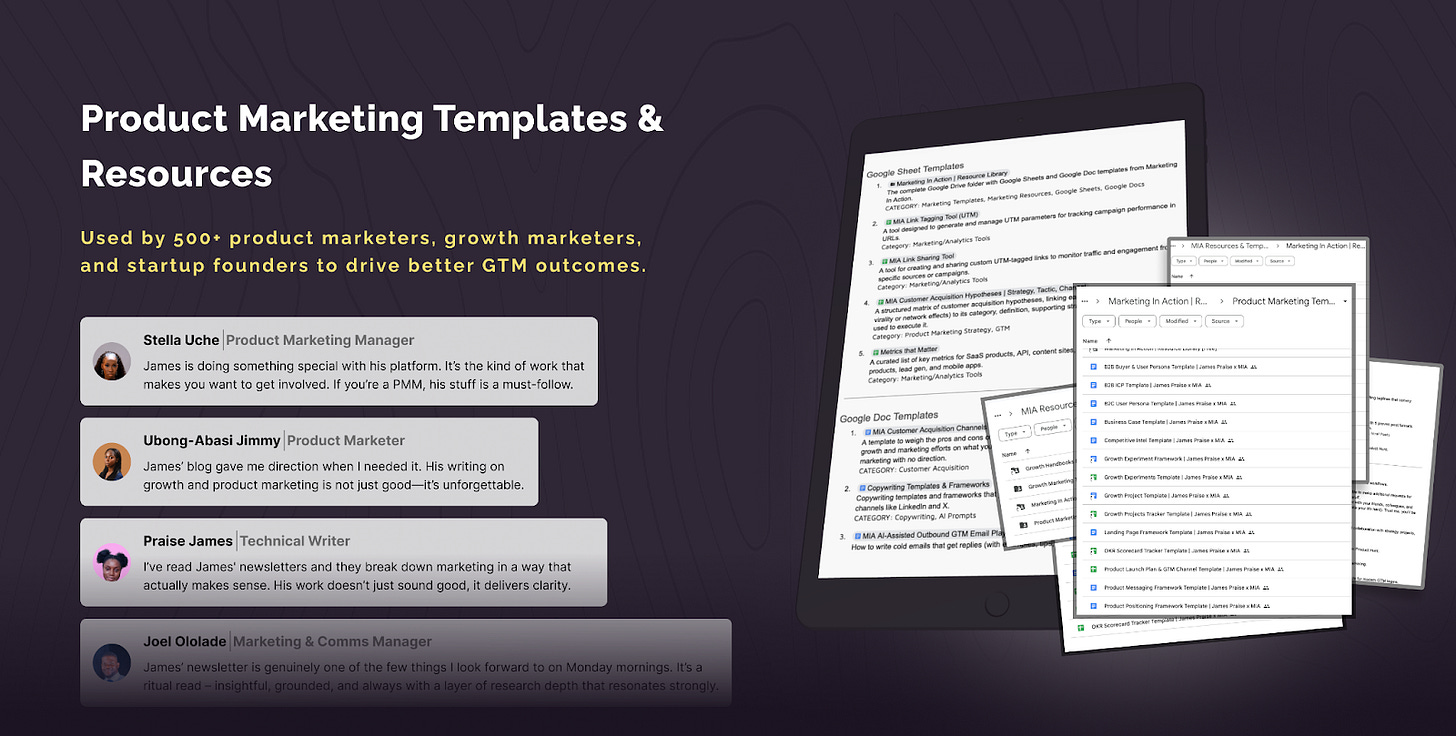MIA #12: How to Prioritize and Run Growth Experiments That Work (+Template)
Growth isn’t hacks. It’s experiments. Use this 8-step framework + ICEEE scoring to stop guessing, learn faster, and build a growth machine.
Thanks for reading MIA—everything you need to put marketing into action—templates, frameworks, community, data, insights, case studies, ideas, and martech/GTM tools. Share it with your network! ~James
When I first started in marketing, I thought growth was about hustle. Try everything—launch ads, write blog posts, post daily on LinkedIn, throw in a webinar, and maybe even experiment with TikTok. Some things spiked, others flopped, but at the end of the month, I couldn’t answer the most important question: what actually worked?
That’s the problem with what I call random acts of marketing. They feel productive, they make the dashboard look busy, but they leave you guessing. It’s like juggling ten balls and hoping at least one doesn’t hit the floor. The truth is, without a system, even your wins can’t be repeated, and your failures get swept under the rug.
My approach to growth transformed when I began to view it as a scientific endeavor rather than a game of chance. By embracing experiments, hypotheses, measurements, and learnings, I moved away from disjointed campaigns towards a systematic process. Successes evolved into repeatable playbooks, failures yielded valuable insights, and growth became a deliberate and predictable outcome.
This is the exact system I use today: an 8-step Growth Experiment Framework plus the ICEEE Prioritization method. Together, they help founders, marketers, and teams move from chaos to clarity. And because I know execution is where the struggle is, I’ve included the exact template in the Premium MIA Resource & Template Library.
👉🏽 Join the Marketing In Action WhatsApp Community, where MIA Newsletter subscribers network, and gossip (what’s trending).
Why random acts of marketing don’t work
Most startups run on adrenaline, vibes, and inshallah. A founder gets an idea, the marketing team scrambles, a campaign goes live, and everyone waits to see what happens. Sometimes, it works. But often, it doesn’t. The worst part? Nobody knows why.
Random acts of marketing are expensive. They burn time, budget, and team energy without building lasting knowledge. Even when something works, it feels like a lucky break, not a repeatable system. And when it fails, it quietly disappears from the backlog, never to be spoken of again.
If this sounds familiar, you’re not alone. Almost every founder or growth team I’ve worked with has gone through this cycle. It’s tempting because activity feels like progress. But activity without learning is just noise.
That’s why experiments matter. They transform chaos into structured learning. Instead of asking, “Did it work?” you start asking, “What did we learn—and how do we use it next time?” That’s the difference between busy teams and teams that actually grow.
Growth is a machine, not a moment
We love stories of “big wins.” The viral post. The ad campaign that crushed. The feature launch that doubled sign-ups. But the truth is, those moments are misleading. Sustainable growth doesn’t come from a single win. It comes from a machine that keeps producing them.
Think of growth like compounding interest. One test gives you a small lift. Ten tests show you patterns. Fifty tests build a playbook that’s almost unfair to your competitors. The magic isn’t in the single experiment—it’s in the momentum of running them consistently.
This is why the best growth teams treat experiments as an operating system. They run small, structured tests. They measure carefully. They document results. And then they systemize the learnings. Over time, this builds a growth engine that doesn’t rely on luck—it relies on process.
The 8-step Growth Experiment Framework
Here’s the backbone of the system. The framework is designed to take you from idea → test → insight → repeatable system.
1—Observation
Every experiment starts with a spark: a data trend, a user behavior, or even a gut feeling worth testing. Maybe sign-ups dropped after you added two extra form fields. Maybe users keep asking for a feature you haven’t prioritized. Write it down.
2—Objective
Define a clear, measurable goal tied to a growth lever (acquisition, activation, retention, referral, revenue). Vague goals like “get more users” don’t cut it. Say, “Increase trial-to-paid conversions by 12% this quarter.”
3—Hypothesis
Good experiments have a testable statement. Use this format: By doing X, we believe Y will happen. If we’re right, we expect Z. Example: “By removing two fields from our sign-up form, we believe conversions will improve. If right, we expect a 10% lift over baseline.”
4—Experiment Design
Split your setup into control (the baseline) and test (the variation). Outline scope, method (A/B test, cohort analysis, etc.), and duration (usually 30 days for v1). Keep it lightweight—you’re validating, not building forever.
5—Considerations
List dependencies and risks. Do you need design support? Is engineering bandwidth limited? Could another project skew results? This step prevents mid-test surprises.
6—Success Criteria
Decide what “winning” looks like before you launch. Is a 10% improvement enough to roll it out? Or do you need 20%? Having thresholds upfront avoids endless debates later.
7—Measurement
Identify your primary metric (the main success signal) and secondary ones (to catch side effects). If you’re testing onboarding, activation rate might be primary, but churn reduction could be secondary. Use tools that can validate statistical significance.
8—Results & Next Steps
Document everything. Wins become playbooks. Losses become insights. Either way, you’ve reduced uncertainty. Then decide: do we productize it (make it the new default) or archive it for future learning?
How do you currently prioritize marketing ideas?
The full resources & template library is subscription-only, but I pulled this template out so you don’t have to miss out. Consider it my way of saying thanks for reading—you can download it here for free.
How to prioritize experiments with ICEEE
Ideas are cheap. Time isn’t. That’s why prioritization matters. The ICEEE Framework is how I score experiments before committing resources.
It looks at five factors:
Impact – How big could this move the needle?
Confidence – How sure are we it will work?
Effort – Engineering – How much dev time is needed?
Effort – Marketing – What’s the marketing lift?
Effort – Other – Any additional ops, product, or support needed?
Each is scored on a 1–10 scale. Impact and Confidence are doubled in weight. Engineering Effort is penalized double because it’s the scarcest resource. The formula:
Score = ((Impact + Confidence) * 2) - (Engineering Effort * 2) - Marketing Effort - Other Effort
What this gives you is a stack-ranked list of high-impact, low-lift experiments. Instead of chasing the loudest idea, you’re choosing the smartest one. It keeps the team aligned, focused, and efficient.
📣 Share this with a founder or marketer on Twitter | LinkedIn | WhatsApp. It takes me 20 hours to write this. Sharing will only take 20 seconds.
Turning insights into systems
The real magic of experiments isn’t the outcome—it’s the systemization.
If your test worked, bake it in. Automate it. Productize it. Or write a playbook so anyone on the team can repeat it. If your test failed, log it in your experiment backlog with context, so the next person doesn’t waste time on the same dead end.
Over time, these small learnings accumulate into a growth library. That library becomes your moat. Competitors can copy a campaign, but they can’t copy your compounding insights. That’s the difference between marketing that’s reactive and marketing that’s built to last.
🧩 Get the full marketing template library.
Get access to 50+ Product & Growth Marketing templates, frameworks, and resources to execute marketing with clarity. Get access here.
TL: DR
Get a PDF summary of this article here.
Random acts of marketing waste time and money without teaching you what actually works.
Growth isn’t hacks—it’s structured experiments that create repeatable wins.
The 8-step Growth Experiment Framework gives you a clear process to follow.
Always start with an observation and set measurable objectives tied to growth levers.
Write hypotheses that are testable and measurable, not vague guesses.
Use ICEEE prioritization to choose high-impact, low-effort experiments.
Engineering effort is the scarcest resource, so weigh it more heavily.
Even failed experiments create valuable learnings if documented properly.
Wins should be systemized into playbooks or productized for repeatability.
Growth is about momentum—stacking small experiments into a machine.
Was this helpful? Hit that ❤️ and let me know your thoughts in the comments! Want to see more of this content? Restack this post (if you’re on Substack) and share it with your friends!
You might find these interesting:
MIA #04 – How to Build a Growth Process & Growth Machine – Learn to make growth predictable, scalable, and repeatable.
MIA #05 – Everything You Need to Know About Growth Marketing – Understand the history, tactics, and motions of growth.
Reforge: Growth Experimentation Framework – See experimentation and testing templates and examples from growth leaders.
Product & Partner Recommendations:
Titaja – TITAJA is an on-demand subscription-based product marketing service (PMaaS) helping product-led, SaaS, and B2B companies unlock growth at every stage of the customer lifecycle, with GTM strategy, positioning, messaging, and demand generation.
James Praise – I help founders of B2B SaaS startups drive product marketing strategy and execution across every stage—positioning, messaging, landing pages, GTM, product launches, lifecycle programs, and growth experiments.
Clay – Clay combines 50+ data providers, real-time scraping, AI, and outbound workflows, so you can send automated, 1-1 personalized campaigns (and book more meetings than your sales team).
Testimonial – Testimonial makes it easy to collect text and video testimonials from your customers in minutes, with no need for a developer or website hosting.
Riverside – Riverside makes it easy to record remote podcasts and video interviews that look and sound like they were recorded in a million-dollar studio.
If you want to collaborate or feature your product in this newsletter, check out our media kit, and shoot me an email.
MIA is trusted by 2,000+ marketers across Africa, the US, and Europe, helping you put marketing in action better, faster, and with context.
We’re building a village of marketers and founders who want to increase their odds of succeeding at marketing. You’re one of us. Share this newsletter with them.









